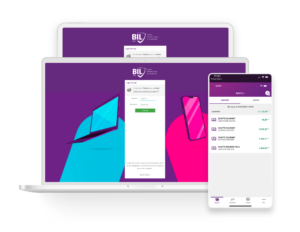Seven steps for effective family budget management
Saving up for something? Keen to learn how to manage your finances more carefully? Or just looking to cut back a little? There’s no secret to it: to manage your money better, all you have to do is stick to your budget. We know that it’s easier said that done. But don’t worry – myLIFE has all the advice you need.
How to manage your budget. Whether you’re living alone or with family, on a tight budget or a comfortable income, keeping tabs on your finances is always a useful way to optimise your capital so you can spend less, invest, carry out projects, save, etc.
To help you with this, myLIFE has seven steps you can follow to determine your optimal budget and adjust it if you need to.
Step 1. Identify your sources of income
If you live beyond your means, you’re bound to find yourself over-indebted sooner or later. So before you consider your spending, it makes sense to think through all of your income streams: salary, rental income, dividends, pension, social security, unemployment benefits, etc.
> Living as a couple but unsure how to split the expenses fairly? Check out myLIFE’s recommended options for how to manage household expenses in a couple.
Step 2. List your monthly expenses
After inflows, we come to outflows. Holding on to your receipts and account statements and keeping a record of what you buy are good habits to adopt. Make sure you track everything you spend, though – even if it’s loose change for the coffee machine!
> If there are any one-off fees you pay during the year (e.g. insurance premiums) don’t forget to factor these in by breaking them down into monthly amounts.
Step 3. Categorise your outflows
Sort your spending into categories: housing, food, transport, insurance, family, healthcare, tax, leisure, gifts, etc.
To make their clients’ lives easier, many Luxembourg banks provide a categorisation tool as part of their online banking service. Make the most of it, and don’t forget to add and categorise everything you spend in cash.
> Remember, each expense can only appear in one category!
The largest outflows in household budgets are housing (30%), everyday consumer spending such as food (20%) and expenses linked to transport (15%).
Step 4. Identify fixed and variable expenses
Determine whether your expenses are fixed (rent and charges, mortgage repayments, telephone/internet, home insurance, etc.) or variable (shopping, leisure, medical expenses, holidays, etc.). Then see which are strictly necessary and which could be reduced. If possible, try to include a fixed amount you’ll set aside every month as savings.
> In general, the largest outflows in household budgets are housing (30%), everyday consumer spending such as food (20%) and expenses linked to transport (15%).
Step 5. Define your goals
Now that you have an overview of your finances, you’re in a better position to analyse your spending habits and make any necessary changes. This exercise usually throws up a few surprises. Afterwards, you may decide to reduce certain types of spending to save money or to avoid ending each month in your overdraft. It will also help you identify and avoid unnecessary spending; on the flipside, you may realise you can treat yourself without a guilty conscience.
Can’t find anything? Maybe you just need to look a little harder! For example, isn’t it time you stopped paying for the gym you haven’t set foot in for months? And that phone contract you took out five years ago – does it really still match your usage patterns? Have you compared it with similar packages from other providers?
Knowing how much you spend each month will make it easier to anticipate your outflows and adjust your spending accordingly.
Step 6. Draw up a provisional budget for the year
Knowing how much you spend each month will make it easier to anticipate your outflows and adjust your spending accordingly. This gives you an opportunity to make advance plans to pay for a holiday, change the tyres on your car or even set aside enough money to buy birthday presents for your nearest and dearest – all while safe in the knowledge that you’re on top of your finances.
> Remember to budget for unexpected expenses: medical bills, replacing your fridge, repairing your car, etc.
Step 7. Stick to your budget!
This step is undoubtedly the hardest to master. To stay on track you’ll have to monitor your finances and try your best to stick to the limits you set in step 6. Keep a daily record of your spending and adjust it over time in order to meet your objectives.
If the thought of having to monitor what you spend every day puts you off, there are tools to help you manage your budget on a daily basis.
Need a little help sticking to your budget?
If you’re not a whizz at using traditional Excel spreadsheets to list each of your expenses (let’s not even mention putting pen to paper) and you prefer tapping away at your smartphone screen or computer keyboard, there are solutions out there that might make your life easier.
Financial institutions now offer daily budget monitoring and management tools.

Your bank’s internet banking services
The most practical and secure option is without doubt your online banking service or the associated mobile app.
More and more financial institutions now offer their clients budgeting services. While most can be used to carry out routine banking operations online (checking account balances, transfers, issuing a bank account details slip (RIB), adjusting limits, etc.), some also offer daily budget monitoring and management tools.
Depending on the bank, you may be able to aggregate your accounts, automatically categorise and classify your expenses, display them in the form of graphs or statistics, set up alerts for suspicious transfers or limit overruns, access personalised advice, etc.
That way, you’ll instantly see whether or not you’re on course to reach your goals.
Budget management tools
You could also opt for a budget management app. There are plenty to choose from on the market, but here are four that offer attractive services:
- The Bankin’ app automatically categorises your expenses, forecasts what your balance will be at the end of the month and makes it easy for you to transfer money from one account to another. This means you can monitor your savings and access support to help you manage your finances.
- The Linxo app pulls in transactions from your various bank accounts, categorises them and warns you if you’re at risk of dipping into your overdraft or if there are unusual transactions involving your accounts. The app can also calculate your monthly savings capacity.
- Mint also offers an account aggregation service, automatic classification of expenses and alert configuration (e.g. payment reminders). Plus, you can create a personalised budget and access financial advice.
- Lastly, Spendee’s key feature is that it allows multiple people to share and manage the same budget, and it also offers classification, alert and customisable analysis services.
Now that you have all the tools you need to manage your money more effectively and meet your goals, it’s time to get started!
If you would like personalised advice on managing your finances or a little help with how to use the bank’s digital tools, feel free to reach out to your banking adviser.


 Mortgage
Mortgage Personal loan
Personal loan Savings
Savings